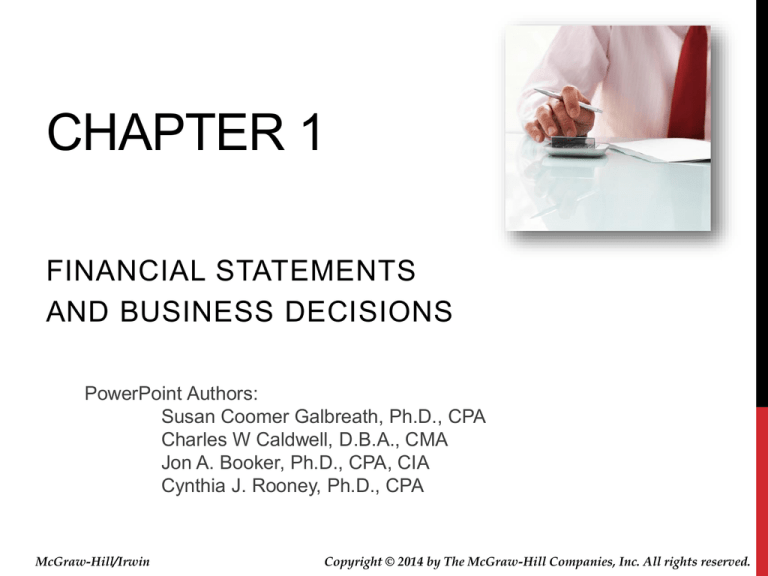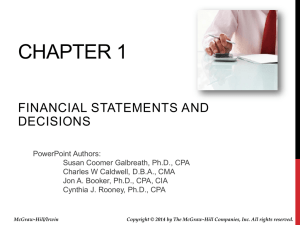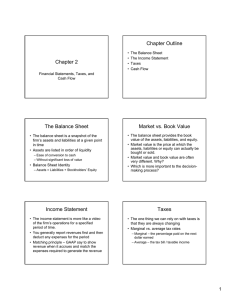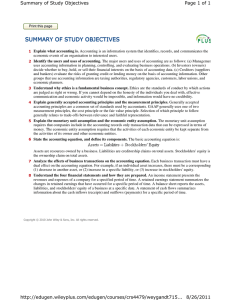
CHAPTER 1
FINANCIAL STATEMENTS
AND BUSINESS DECISIONS
PowerPoint Authors:
Susan Coomer Galbreath, Ph.D., CPA
Charles W Caldwell, D.B.A., CMA
Jon A. Booker, Ph.D., CPA, CIA
Cynthia J. Rooney, Ph.D., CPA
McGraw-Hill/Irwin
Copyright © 2014 by The McGraw-Hill Companies, Inc. All rights reserved.
UNDERSTANDING THE BUSINESS
Stockholders
Potential Return for
Stockholders:
Dividends
Higher future stock prices
Creditors
Potential Return for
Creditors:
Interest
1-2
THE ACCOUNTING SYSTEM
1-3
BUSINESS ACTIVITIES
Financing Activities
Ex: Borrow money
from bank
Investing Activities
Ex: Purchase
equipment
Operating Activities
Ex: Sell merchandise
to customers
1-4
THE FOUR BASIC FINANCIAL
STATEMENTS
BALANCE SHEET – reports the amount of assets, liabilities, and
stockholders’ equity of an accounting entity at a point in time.
INCOME STATEMENT – reports the revenues less the expenses of the
accounting period.
STATEMENT OF STOCKHOLDERS’ EQUITY – reports the changes in
each of the company’s stockholders’ equity accounts, including the
change in the retained earnings balance caused by net income and
dividends during the reporting period.
STATEMENT OF CASH FLOWS – reports inflows and outflows of cash
during the accounting period in the categories of operating, investing,
and financing.
1-5
BALANCE SHEET
Elements of the Balance Sheet
Assets
Cash
Short-Term Investment
Accounts Receivable
Notes Receivable
Inventory (to be sold)
Supplies
Prepaid Expenses
Long-Term Investments
Equipment
Buildings
Land
Intangibles
Liabilities
Accounts Payable
Accrued Expenses
Notes Payable
Taxes Payable
Unearned Revenue
Bonds Payable
Stockholders’ Equity
Common Stock
Retained Earnings
1-6
THE ACCOUNTING EQUATION
A = L + SE
Assets
Economic
Resources
Liabilities
Stockholders’
Equity
Sources of Financing for Economic
Resources
Liabilities: From Creditors
Stockholders’ Equity: From Stockholders
1-7
BALANCE SHEET
1-8
INCOME STATEMENT
Elements of the Income Statement
Revenues
Sales Revenue
Fee Revenue
Interest Revenue
Rent Revenue
Expenses
Cost of Goods Sold
Wages Expense
Rent Expense
Interest Expense
Depreciation Expense
Advertising Expense
Insurance Expense
Repair Expense
Income Tax Expense
1-9
INCOME STATEMENT
1-10
STATEMENT OF
STOCKHOLDERS’ EQUITY
Elements of the Statement
of Stockholders’ Equity
Common Stock
Retained Earnings
Beginning Retained Earnings
+Net Income
-Dividends
Ending Retained Earnings
1-11
STATEMENT OF
STOCKHOLDERS’ EQUITY
1-12
STATEMENT OF CASH FLOWS
Elements of the Statement
of Cash Flows
Cash Flows from Operating Activities
Cash Flows from Investing Activities
Cash Flows from Financing Activities
/
Note that each of the three cash flow
sources can be positive (net cash inflow)
or negative (net cash outflow).
1-13
STATEMENT OF CASH FLOWS
1-14
RELATIONSHIPS AMONG THE
STATEMENTS
1-15
NOTES
Did you notice a sentence at the
bottom of each financial statement?
All financial statements
should be accompanied by
notes which provide the
reader with supplemental
information about the financial
condition and results of
operations of the company.
1-16
FINANCIAL STATEMENT SUMMARY
1-17
RESPONSIBILITIES FOR THE ACCOUNTING
COMMUNICATION PROCESS
The Rules
Generally
Accepted
Accounting
Principles
(GAAP)
1-18
HOW ARE GENERALLY ACCEPTED
ACCOUNTING PRINCIPLES DETERMINED?
Our accounting system has a long
and distinguished history. An
Italian monk and mathematician,
Luca Pacioli, published the first
elements of double-entry
bookkeeping in 1494.
Prior to 1933, the management
teams of most companies were
largely free to choose their own
financial reporting practices.
1-19
GENERALLY ACCEPTED
ACCOUNTING PRINCIPLES
Securities Act of 1933
Securities and Exchange Act of 1934
The Securities and Exchange Commission (SEC)
has been given broad powers to determine
measurement rules for
financial statements.
1-20
GENERALLY ACCEPTED
ACCOUNTING PRINCIPLES
The SEC has worked closely with the
accounting profession to
work out the detailed rules that have
become known as GAAP.
Currently, the Financial Accounting Standards Board
(FASB) is recognized as the body to formulate GAAP.
1-21
GENERALLY ACCEPTED
ACCOUNTING PRINCIPLES
Companies incur the cost of
preparing the financial statements
and bear the following economic
consequences of their publication . . .
Effects on the selling price of stock.
Effects on the amount of bonuses
received by managers and other employees.
Loss of competitive information to other
companies.
1-22
INTERNATIONAL PERSPECTIVE
The International Accounting Standards Board and
Global Convergence of Accounting Standards
Since 2002, there has been substantial movement toward the adoption of
International Financial Reporting Standards (IFRS) issued by the
International Accounting Standards Board (IASB).
Examples of jurisdictions requiring the use of IFRS either currently or by 2012:
• European Union
• Israel and Turkey
• Australia and New Zealand
• Brazil and Chile
• Canada and Mexico
• Hong Kong, India, Malaysia, & South Korea
In the United States, the Securities and Exchange Commission now allows
foreign companies whose stock is traded in the U.S. to use IFRS and is
considering requiring the use of IFRS for U.S. domestic companies by 2015.
1-23
ETHICAL CONDUCT
Three Step Process for Making Ethical Decisions
1. Identify the benefits of a decision (often to the
manager or employee involved) and who will
be harmed (other employees, owners,
creditors, the environment).
2. Identify alternative courses of action.
3. Choose the one you would like your family and
friends to see reported on your local news.
1-24
ENSURING THE ACCURACY OF
FINANCIAL STATEMENTS
To ensure the accuracy of the company’s
financial information, management:
Maintains a system of controls.
Hires external independent auditors.
Forms a committee of the board of directors
to review these other two safeguards.
1-25
EXTERNAL AUDITORS
An audit is an examination
of the financial reports to
ensure that they represent
what they claim and
conform with GAAP.
Overall, I believe
these financial
statements are
fairly stated.
1-26
WHAT IF THE NUMBERS ARE
WRONG?
After it was determined that the financial statements for Le-Nature’s
were misleading, the consequences for the defendants were severe.
1-27
SUPPLEMENT A: TYPES OF BUSINESS
ENTITIES
Sole Proprietorship: owned by a single individual.
Partnership: owned by two or more individuals.
Corporation: ownership represented by shares of stock.
Advantages of a Corporation:
Limited liability
Continuity of life
Ease of transfer of ownership
Opportunity to raise large amounts of money
Disadvantage of a Corporation:
Double taxation
1-28
SUPPLEMENT B: EMPLOYMENT IN THE
ACCOUNTING PROFESSION TODAY
Professional
Designations
CPA
CMA
CIA
Career Opportunities
Public Accounting
Audit and Assurance Services
Management Consulting Services
Tax Services
Employment by Organizations
Internal accounting
External reporting
Tax planning
Various other functions
Employment in the Public and Notfor-Profit Sector
1-29
END OF CHAPTER 1
1-30







